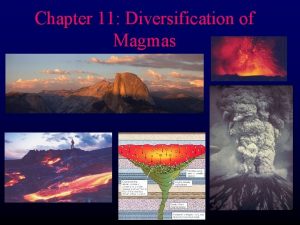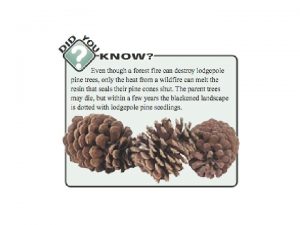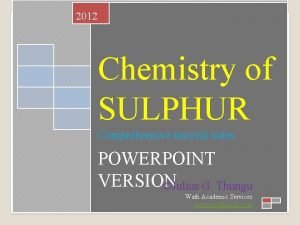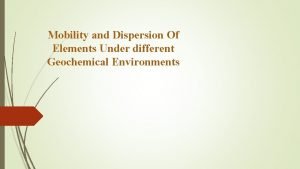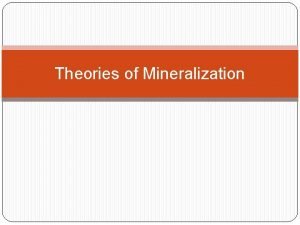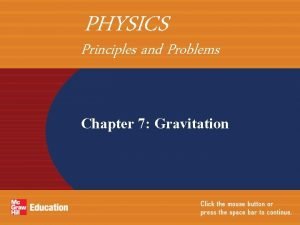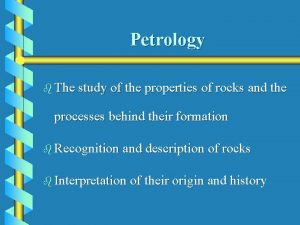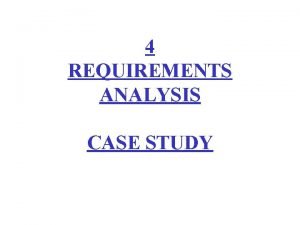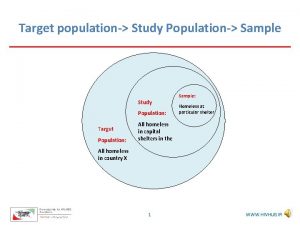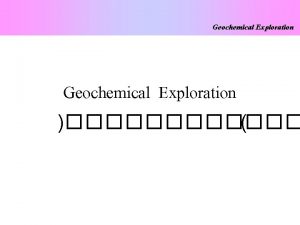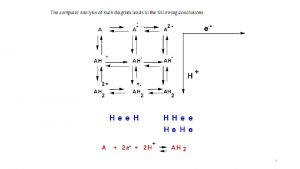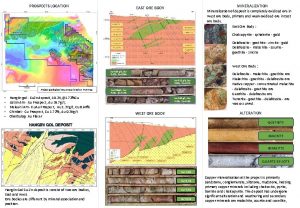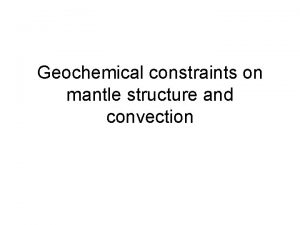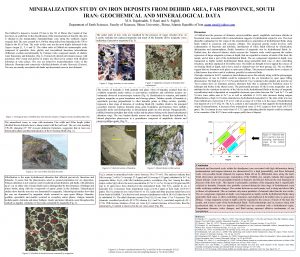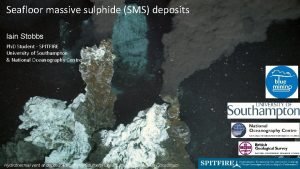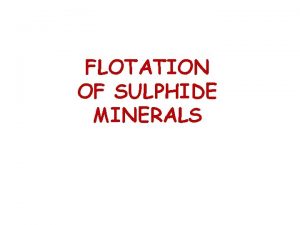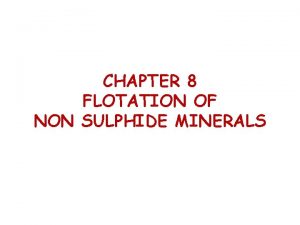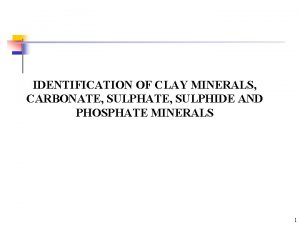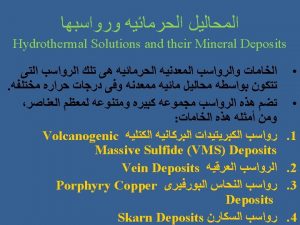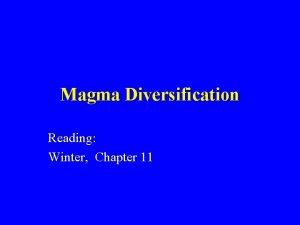A Geochemical study of magmatic NiCuPGE sulphide mineralization

















































- Slides: 49

A Geochemical study of magmatic Ni-Cu-PGE sulphide mineralization in mafic sills at Melba Flats, Western Tasmania Reid R. Keays School of Earth, Atmosphere and Environment Monash University October 17, 2014

Executive Summary • The ore-grade Ni-Cu-PGE sulphides at Melba Flats were formed at depth due to interaction of a PGE-undepleted high Mg. O magma with S-bearing crustal rocks • Some of these sulphides were then picked up as liquid sulphide droplets and transported by later batches of the same magma type • During transport, some of the sulphides were resorbed by the sulphideundersaturated magma • As a result some of the Fe and the S in the sulphides were taken back into the magma, leaving residual sulphides that were enriched in Cu, Ni, PGE and Se • As it is highly probable that only a small proportion of the Ni-Cu-PGE sulphides formed at depth were transported to their current sites, there is considerable potential for significant amounts of additional sulphides at depth • If present, these sulphides would have somewhat lower tenors than the Melba Flats high grade sulphides – However, the tenors of these sulphides are likely to be quite economically attractive as the tenors of the Melba Flats sulphides (~10 % Ni and ~5 % Cu) are significantly higher than many Ni-Cu sulphide deposits

Background to Study • This project is a follow-up to the Crawford and Keays (2010) report on Melba Flats prepared for Allegiance Mining • It was set up to address the question: – did the Ni-Cu-PGE sulphides at Melba Flats acquire their metal tenors at depth when first formed - or did they start off as sedimentary sulphides that acquired their metal content during transport • If the former, then there may be significant amounts of magmatic Ni-Cu-PGE sulphides at depth in the Melba Flats magmatic system

Geological Background • Magmatic Ni-Cu-(PGE) sulphides were discovered at Melba Flats in ~1893 • Total estimated production was 6050 tons @ 9. 7% Ni and 4. 7% Cu • Much of the production came from high grade (up to 15% Ni+Cu) lodes up to 1 m thick that occur in relatively narrow gabbroic sills that were intruded into mudstones, siltstones and volcanic lithiewackes of the Late Proterozoic Crimson Creek Formation • In addition to Ni + Cu, the mineralization contains a considerable amount of PGE – The highest Pd and Pt values recorded in this study were 3. 32 g/t Pd and 1. 02 g/t Pt – The PGE contents of the mineralized rocks at Melba Flats are similar to those of contact Ni-Cu-PGE sulphides at Sudbury, Canada • In drill hole MF 93, the most studied drill hole in this project, the widths of the sills vary from 7 m to 59 m thick • Melba Flats is about 25 km to the NE of Avebury, a significant hydrothermal Ni deposit

Rosebery Renison MELBA ine p S is Ax Henty Zeehan AVEBURY Mafic - ultramafic outcrop Granite <2 km depth Deposits

Massive Ni-Cu-PGE sulphides in Melba Flats drill core -635 ppb Pd, 767 ppb Pt, 69 ppb Rh, 126 ppb Ir, 3. 8% Cu, 5. 5% Ni

Melba Flats – North Cuni Genets Section 5367825 2100 m RL MF 95 3. 2 m @ 1. 1% Ni & 0. 8% Cu MF 88 5. 1 m @ 0. 8% Ni, 0. 7% Cu Crimson Creek Formation Greywackes 1900 m RL Gabbro Dykes 366600 E 366500 E

Important Note • In some of the Melba Flats sills, massive sulphides make up to 85% of the volume of the sills • In other sills, several veins of massive sulphide occur at different depths in the sills – This suggests that the sulphides were injected into the sills as sulphide melts • There is no contact metamorphic effects in the greywacke host rocks to the sills

58 60 MF-23 62 Depth (m) 64 66 68 70 72 74 76 0, 001 0, 1 Ni (wt%) 1 10 100

Ni vs Depth in MF-23 Sill 2 • There are four Ni peaks in this intersection that were produced by massive sulphide aggregates and veins • This provides additional strong evidence that the sulphides were injected as immiscible sulphide liquids into the gabbros • These sulphide melt may have been injected from below or by backward flow • It will be shown below that it is unlikely that the mineralization is a product backward flow of sulphide melts

Magma-type that formed the Melba Flats Ni-Cu-PGE sulphides • An indication of the magma type from which the higher grade Ni-Cu-PGE sulphides were formed is provided on a scattergram of Pd/Ir vs Ni/Cu ratios • These values are superimposed on the discriminant diagram of Barnes (1990) that provides the fields occupied by rocks formed by different magma types


Pd/Ir vs Ni/Cu • The majority of the sulphides plot in the field of high Mg tholeiites • Hence, the ores were formed by a magma that had the same Mg. O content (~12 -13%) as that which the host rocks (Crawford and Keays, 2010) • Magmas that have elevated Mg. O contents are generally sulphide undersaturated and therefore undepleted in Ni, Cu and the PGE • The three MF 81 A samples that lie outside the high Mg tholeiite field are massive sulphides – they have lost some Pd, Pt and Cu during fractionation of the sulphide melt that produced them • Symbols: red circles (MF 19 Assays); pink squares (MF 95); yellow circles (MF 81 A); green squares (MF 93 -sill 1); sky blue squares (MF 93 -sill 2); blue squares (MF 93 -sill 3); orange squares (MF 93 -sill 4)

A note on fractionation of sulphide melts • Sulphide melts can undergo fractionation, just as silicate melts do • The first phase to segregate from the sulphide melt that produced the sulphide mineralization at Melba Flats would be a Monosulphide solid solution (Mss) that would be composed mainly of Fe. S plus Ni and Co in addition to Ir, Ru and Rh • The residual sulphide melt would be enriched in Cu, Au, Pd and Pt • Migration of the Cu-rich sulphide melt away from the Mss (as would almost certainly have happened if the Melba Flats sulphides had flowed backwards down the plumbing system) would have produced significant fractionation of Cu from Ni and Pd from Ir, etc.

There is a reasonable correlation between Cu and Ni -the divergence in Cu/Ni ratios may in part be due to limited fractionation of a sulphide melt 100000 10000 MF 19 Assays MF 19 Cu (ppm) MF 83 1000 MF 95 MF 81 A MF 23 -Sill 1 100 MF 23 -Sill 2 MF 93 -Sill 1 MF 93 Sill 2 10 MF 93 -Sill 3 MF 93 -Sill 4 1 10 10000 Ni (ppm) 1000000

10000, 0 MF 19 MF-19 assays 1000, 0 MF 83 Pd (ppb) MF 95 MF 81 A 100, 0 MF 23 -Sill 1 MF 23 -Sill 2 MF 93 -Sill 1 10, 0 MF 93 Sill 2 MF 93 -Sill 3 MF 93 -Sill 4 1, 0 0, 1 0 1 10 100 Pt (ppb) 10000

Pd vs Pt • Excellent Pd-Pt correlation between Cu-Ni-rich and Cu. Ni-poor sulphides • The continuum in ratios indicates the sulphides in all sills are co-magmatic • This also indicates that all of the PGE in the rocks (including those with very low sulphide contents) are hosted by sulphides • The scatter in ratios with higher PGE contents may be due to the presence of Platinum Group Minerals • Also, the MF-19 “Assays” samples were analysed in a different lab

1000, 0 100, 0 MF-19 assays Ir (ppb) MF 95 10, 0 MF 81 A MF 93 -Sill 1 1, 0 MF 93 Sill 2 MF 93 -Sill 3 MF 93 -Sill 4 0, 1 0, 0 0 1 10 100 Pd (ppb) 10000

Ir vs Pd • There is a reasonably strong correlation between Ir and Pd • As Ir and Pd are strongly partitioned during fractionation of sulphide melts, this suggests the sulphide melts underwent very little fractionation • If fractionated, the high Pd samples should have low Ir contents, which they do not • It is hence unlikely that the sulphides were emplaced at higher levels in the plumbing system and ran back down the system under gravity

1000, 0 MF-19 assays 100, 0 Rh (ppb) MF 95 MF 81 A 10, 0 MF 93 -Sill 1 MF 93 Sill 2 1, 0 MF 93 -Sill 3 MF 93 -Sill 4 0, 1 0, 0 0 1 10 Pt (ppb) 1000

Rh vs Pt • There is strong correlation between Rh and Pt • This means that there was no fractionation of a sulphide melt during emplacement of the sulphides • It is unlikely that there was backward flow of a sulphide melt as this would have resulted in fractionation of Ni from Cu and Pd from It • The strong correlation between Rh and Pt excludes any possibility that the sulphides are hydrothermal in origin

10000 MF 19 PGE-Undepleted MF-19 assay 1000 R ble MF 95 F ria Va MF 81 A MF 23 -Sill 1 10 MF 23 -Sill 2 on MF 93 -Sill 1 MF 93 Sill 2 ple ti 1 De MF 93 -Sill 3 ide MF 93 -Sill 4 lph 0 PGE-Depleted Su Pd (ppb) 100 MF 83 ors act 0 0 1 10 100 Cu (ppm) 1000 R-factor – volume of silicate magma/volume of sulphide melt 100000

Pd vs Cu • The dashed line separates samples that were formed from PGE-undepleted magmas from those formed from PGE-depleted magma • The samples lying above the dashed line were formed from a sulphide-undersaturated magma under a range of R-factors • Samples with low Pd/Cu ratios were formed by magmas that became depleted the PGE due to scavenging by magmatic sulphides • It will be argued that in the case of Melba Flats, this scavenging of the PGE occurred during transport of immisicible magmatic sulphides formed at depth

320 Mantle Cu/Pd 330 Depth (m) 340 350 360 370 PGE Depletion 380 390 1000 MF 81 A 100000 Cu/Pd 1000000

Cu/Pd variations in MF 23 -Sill 4 • The mantle has a Cu/Pd ratio of ~ 7500 • Rocks that have much higher Cu/Pd ratios were formed from magmas that were strongly depleted in Pd and the other PGE • This would have been caused by a sulphidesaturation event which would have also removed Cu and Ni • With the exception of the gabbros at the base and the top of the sill, the gabbroic rocks in this sill were formed by magmas that had undergone a significant sulphide-saturation event

Notes on S/Se geochemistry • Mantle-derived magmas have a S/Se ratios of 2500 ± 500 • Most S-bearing sedimentary rocks have considerably larger S/Se ratios • Hence, S/Se ratios can be used to determine if a portion of the S component of magmatic sulphides is “mantle” in origin or “crustal” in origin • Whereas the strongly mineralized rocks at Melba Flats have “mantle” S/Se ratios, many of the poorly mineralized (but still Sbearing) have “crustal” S/Se ratios • If a S-undersaturated magma were to transported sulphides with low metal tenors and high S/Se ratios, those sulphides could be partially resorbed by the magma, taking Fe and S back into the magma but enriching the residual sulphides in the PGE, Cu, Au, Ni and Se, all of which have larger sulphide melt/silicate melt partition coefficients

100000 MF 19 MF 83 MF 95 10000 Cu (ppm) MF 81 A MF 23 -Sill 1 MF 23 -Sill 2 1000 MF 93 -Sill 1 MF 93 Sill 2 MF 93 -Sill 3 MF 93 -Sill 4 100 10 0 2000 4000 S/Se 6000 8000 10000

Cu vs S/Se • Most of the well-mineralized rocks at Melba Flats have narrow range in S/Se • The three MF 81 A samples with elevated Cu that have higher S/Se are three outliers on the Pd/Ir vs Ni/Cu plot – The Se in these samples probably entered the Cu-rich sulphide melt • The majority of the poorly mineralized rocks have considerably higher S/Se ratios, which are indicative of crustal S

35 30 Mantle Cu (100) (wt%) 25 20 MF 19 MF 83 MF 95 MF 81 A 15 MF 23 -Sill 1 Crustal Sulphur 10 MF 23 -Sill 2 MF 93 -Sill 1 MF 93 Sill 2 5 MF 93 -Sill 3 MF 93 -Sill 4 0 0 2000 4000 S/Se 6000 8000 10000

Cu tenor vs S/Se • In general, Cu tenors (=Cu (100) increase with decreasing S/Se • The high S/Se ratios of the low Cu(100) samples indicate that they contain a significant amount of crustal S • These patterns suggest that the sulphides initially had high S/Se (and high (=crustal) δ 34 S) but during transport in a S-undersaturated magma, Fe and S were resorbed by the magma – This resulted in the residual sulphides becoming enriched in Cu, PGE and Se • Two of the samples have sub-mantle S/Se ratios – This indicates even greater interaction with the carrier magma than with the other sulphides

156 158 160 Depth (m) 162 164 166 168 170 172 174 MF 81 A 176 10 1000 Cu (ppm) 100000

156 158 MF 81 A 160 Depth (m) 162 164 166 168 170 172 174 176 10000 Ni (ppm) 1000000

Cu and Ni vs Depth in MF 81 A • Massive sulphides occur at the base of the sill -their Cu and Ni contents reach maximums of 4. 0 % and 14. 5 %, respectively -both Cu and Ni decrease very rapidly up through the sill • This distribution of metals would be produced if the sulphides had been carried as immiscible sulphide droplets by the magma and then settled to the base of the sill once the magma stopped flowing

162 MF 81 A Mantle 164 Depth (m) 166 168 170 172 Crustal contamination 174 176 0 1000 2000 3000 S/Se 4000 5000 6000 7000

S/Se vs depth in MF 81 A • The massive sulphides at the base of the sill have a narrow range (2020 to 2770) in S/Se ratios that fall within the mantle range • Samples with lower sulphide content higher in the sill have higher S/Se (up to 6000) ratios that indicate a component of crustal S • There is a strong inverse correlation between S/Se and Cu and Ni (as well as the PGE)

Genetic Model • The Melba Flats Ni-Cu-PGE sulphides were deposited at depth due to interaction of a sulphide-undersaturated high-Mg. O magma with S-bearing crustal rocks • This produced magmatic sulphides with elevated S/Se ratios (and probably high δ 34 S values) • Some of these sulphides were then picked up and transported by later batches of the same magma type • During transport, some of the sulphides were resorbed by the sulphideundersaturated magma • As a result some of the Fe and the S in the sulphides were taken back into the magma, leaving residual sulphides that were enriched in Cu, Ni, PGE and Se • This increased the metal tenors of the sulphides but decreased their S/Se ratios • Conversely, the S/Se ratios of the carrier magma increased while its PGE content decreased due to scavenging into the residual sulphides • Once the magmas flowing rate in the sills slowed down, the sulphide melt droplets settled to the bases of the sills • However, in some cases. the sulphide melts were remobilized and injected into the sills at higher levels in them, as in the case of MF 23 -Sill 2

Mineralized vs barren gabbro sills • Were the mineralized sills produced by different magmas to those the produced by barren sills? • This question can be addressed by using spidergrams that are constructed utilizing the petrogenetic indicator elements

1000 MF 95 -121. 8 -Min MF 81 A-163. 5 Min MF 83 -143. 7 -Min Sample/Primitive Mantle MF 23 -48. 35 -Barren MF 93 -323. 3 -Barren 100 MF 93 -368. 86 -Barren 10 1 Ba Th Nb La Ce Nd Sr Sm Zr Ti Eu Gd Dy Er Yb

Extended Spidergram • There is no difference in the petrogenetic trace patterns between the barren and the mineralized sills/dykes • This provides strong evidence that all the sills are comagmatic • There is a small negative Nb anomaly, which is consistent with some crustal contamination

1, 0 MF 83 0, 9 Primitive Magma MF 95 0, 8 MF 81 A MF 23 -Sill 1 0, 7 (Nb/Th)PM MF 23 -Sill 2 0, 6 MF 93 -Sill 1 0, 5 MF 93 Sill 2 MF 93 -Sill 3 0, 4 MF 93 -Sill 4 0, 3 0, 2 Crustal con taminant 0, 1 0, 0 0 5 10 15 (Th/Yb)PM 20 25 30

(Nb/Yb)PM vs (Th/Yb)PM* • Decreasing (Nb/Yb)PM and increasing Th/Yb)PM indicate increasing degrees of crustal contamination • Most samples have undergone a modest degree of crustal contamination (<5%) • The solid line represents a mixing line between a primitive magma (with low (Th/Yb)PM and a crustal contaminant (with high (Th/Yb)PM • The tightness of the array indicates that there was excellent homogenization between the parental magma and the crustal contaminant * PM- values for each element have normalized to their concentration in the Primitive Mantle

Gabbroic sill at Avebury • Samples were analysed from a gabbroic sill in the Crimson Creek Formation at Avebury • As the sequence is overturned, this sill is in the stratigraphic footwall to the Avebury ultramafic body • These samples were collected analysed to see if they are co-magmatic with the gabbroic sills at Melba Flats • The study of this sill is a part of Marcus Phua’s MSc project on Melba Flats

Sample/Primitive Mantle 100, 00 1, 00 MF 23 -Sill 1 MF 93 -Sill 4 -323. 3 0, 10 MF 93 -Sill 4 -368. 86 A-254 -634. 6 A-254 -638. 8 0, 01 Ba Th Nb La Ce Nd Sr Sm Zr Ti Eu Gd Dy Er Yb

Extended Spidergram-Avebury Gabbro Sill • The patterns for the two Avebury samples (A-254) are completely different to those of the Melba Flats sills • Hence, the Avebury sill is not co-magmatic with the Melba Flats sills • The Avebury samples define, with the exception of Ce, the Ushaped REE pattern that is typical of boninites • They also have very strong negative Nb anomalies, a feature that is also typical of boninites • Although the Avebury gabbroic sill was probably affected by the same fluids that ultimately came off the Heemskirk granite and metasomatized the Avebury ultramafic, the geochemical data do suggest that the Avebury gabbroic sill was formed by a boninitic magma • If this is indeed the case, it would strengthen the case that the Avebury ultramafic body was formed by a boninitic magmas and is indeed a member of the Early Cambrian Heazlewood River ultramafic/mafic suite of intrusions

Sulphur Isotope data for Avebury sulphides • Sulphur isotopes were measured in 18 Avebury samples which contained variable amounts of Ni • These data were collected as a part of Ben Mackay-Scollay’s BSc (Honours) project on Avebury • The samples were analysed at Queens University in Canada • The data are reported here because of the possible relevance to mineralization at Melba Flats


Sulphur Isotope Data for Avebury mineralization • Average δ 34 S = 17. 1 ± 1. 1 • The Avebury sulphides have higher δ 34 S values than the majority of magmatic Ni-Cu sulphide deposits with the exception of Noril’sk (Russia) and Duluth (USA) • These high and very uniform δ 34 S values rule out any possibility that Avebury is a strongly metasomatised magmatic Ni. S deposit • The high δ 34 S values indicate that the Heemskirk Granite, the source of the metasomatising fluids, could not have been the source of the heavy S • The most logical source of the heavy S would be the same as that of the Ni, this being magmatic Ni sulphides somewhere at depth in the plumbing system at Avebury • Is it possible that the magmatic sulphides at Melba Flats were derived from a similar source?

Confirmation of the Genetic model for Melba Flats • The δ 34 S values of the Melba Flats sulphides will be determined to test the model proposed for their petrogenesis • If the higher grade magmatic sulphides at Melba Flats are the product of partial resorption of sulphides produced by the interaction of a primitive magma with S-bearing sedimentary rocks that had high S/Se ratios, they might also have high δ 34 S values • Although some of the S in those sulphides would be assimilated by the sulphide undersaturated magma (and therefore increase its S/Se ratios) this would probably not fractionate the S isotopes • Hence, the genetic model proposed for Melba Flats would be confirmed if the higher grade sulphides have high δ 34 S values

References • Barnes S-J 1990 The use of metal ratios in prospecting for a platinum-group element deposit Journal of Exploration Geochemistry. 37: 91 -99 • Crawford AC, Keays RR (2010) Magmatic Ni-Cu sulfides in mafic sills at Melba Flats, Western Tasmania-a geochemical investigation. Unpubl. Report prepared for Allegiance Minerals, 34 pages.
 Ansi h2s standard
Ansi h2s standard Poise
Poise Practice geochemical cycles answer key
Practice geochemical cycles answer key Soulable sulphide analysis presentation
Soulable sulphide analysis presentation Magmatic intrusion
Magmatic intrusion Iron 2 sulphide
Iron 2 sulphide Primary dispersion
Primary dispersion Theories of mineralization
Theories of mineralization Phytogeography region of india
Phytogeography region of india Retrospective cohort study
Retrospective cohort study Difference between time study and motion study
Difference between time study and motion study What is work study in management
What is work study in management Distinguish between time study and motion study
Distinguish between time study and motion study Marty lobdell study less study smart
Marty lobdell study less study smart What is case series
What is case series Chapter 16 primate evolution study guide answer key
Chapter 16 primate evolution study guide answer key Ecology is the study that helps to preserve
Ecology is the study that helps to preserve Study group 17
Study group 17 Study programme example
Study programme example Chapter 7 study guide gravitation
Chapter 7 study guide gravitation Petrology is the study of
Petrology is the study of Ten themes of biology
Ten themes of biology Task 2 study the advertisement
Task 2 study the advertisement Forest study buddy
Forest study buddy Two ways to change worksheet
Two ways to change worksheet Causal comparative
Causal comparative Ponyboy's goals
Ponyboy's goals Heineken value chain
Heineken value chain Experiment vs study
Experiment vs study Elearning adaptivity case study
Elearning adaptivity case study A primary reason that geographers study maps is to
A primary reason that geographers study maps is to Requirement analysis case study
Requirement analysis case study Management information system case study
Management information system case study Chapter 12 states of matter study guide
Chapter 12 states of matter study guide Pilot experiment
Pilot experiment Bar study loans
Bar study loans Forensics ballistics
Forensics ballistics Identify the energy conversions in the illustration below
Identify the energy conversions in the illustration below What is a study population
What is a study population Fhir imaging study
Fhir imaging study What happens to tom robinson in chapter 23
What happens to tom robinson in chapter 23 Facebook distributed system case study
Facebook distributed system case study Research paradigm example thesis
Research paradigm example thesis Pols 1101 final exam
Pols 1101 final exam A formal study of information retrieval heuristics
A formal study of information retrieval heuristics Vce chinese second language study design
Vce chinese second language study design Comp 311 textbook notes
Comp 311 textbook notes Target corporation case study
Target corporation case study Chapter 14 accounting test
Chapter 14 accounting test Stages in research
Stages in research

